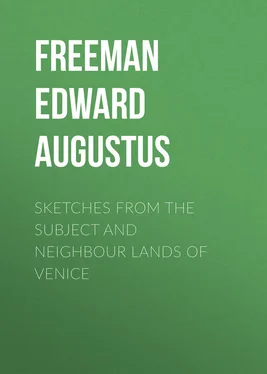Edward Freeman - Sketches from the Subject and Neighbour Lands of Venice
Здесь есть возможность читать онлайн «Edward Freeman - Sketches from the Subject and Neighbour Lands of Venice» — ознакомительный отрывок электронной книги совершенно бесплатно, а после прочтения отрывка купить полную версию. В некоторых случаях можно слушать аудио, скачать через торрент в формате fb2 и присутствует краткое содержание. Жанр: foreign_antique, foreign_prose, Путешествия и география, на английском языке. Описание произведения, (предисловие) а так же отзывы посетителей доступны на портале библиотеки ЛибКат.
- Название:Sketches from the Subject and Neighbour Lands of Venice
- Автор:
- Жанр:
- Год:неизвестен
- ISBN:нет данных
- Рейтинг книги:3 / 5. Голосов: 1
-
Избранное:Добавить в избранное
- Отзывы:
-
Ваша оценка:
- 60
- 1
- 2
- 3
- 4
- 5
Sketches from the Subject and Neighbour Lands of Venice: краткое содержание, описание и аннотация
Предлагаем к чтению аннотацию, описание, краткое содержание или предисловие (зависит от того, что написал сам автор книги «Sketches from the Subject and Neighbour Lands of Venice»). Если вы не нашли необходимую информацию о книге — напишите в комментариях, мы постараемся отыскать её.
Sketches from the Subject and Neighbour Lands of Venice — читать онлайн ознакомительный отрывок
Ниже представлен текст книги, разбитый по страницам. Система сохранения места последней прочитанной страницы, позволяет с удобством читать онлайн бесплатно книгу «Sketches from the Subject and Neighbour Lands of Venice», без необходимости каждый раз заново искать на чём Вы остановились. Поставьте закладку, и сможете в любой момент перейти на страницу, на которой закончили чтение.
Интервал:
Закладка:
At last, by whichever road he goes, the traveller finds himself at the little town of Monfalcone, and there he who comes by the railway must now look for the capital barouche and the excellent horses, or such substitutes for them as Monfalcone can supply. A small castle frowns on the hill above the station, but the town contains nothing but an utterly worthless duomo and some street arcades, to remind us once more that, if we are under the political rule of the Apostolic King, we are on soil which is Italian in history and in architecture. After a railway journey which has mainly skirted the sea, perhaps even after a journey over the hills during a great part of which we have looked down on the sea, we are a little surprised at finding that the road which leads us to what once was a great haven takes us wholly inland. We pass through a flat and richly cultivated country, broken here and there by a village with its campanile, till two Corinthian columns catch the eye in front of a modern building, which otherwise might be passed by without notice. Those two columns, standing forsaken, away from their fellows, mark that we have reached Monastero; in the days before Attila we should have reached Aquileia. We are now within the circuit of the ancient colony. But mediæval Aquileia was shut up within far narrower limits; modern Aquileia is shut up within narrower limits still. Within the courtyard of the building which is fronted by the two columns, we find a large collection, a kind of outdoor museum, of scraps of architecture and sculpture, the fragments of the great city that once was. We go on, and gradually our approach to the centre is marked by further fragments of columns lying here and there, as at Rome or Ravenna. A little farther, and we are in modern Aquileia, "città Aquileia," as it still proudly calls itself in the official description, which, as usual, proclaims to the traveller the name of the place where he is, and in what administrative division of the "Imperial and Royal" dominions he finds himself.
Of the village into which the ancient colony has shrunk up we must allow that the main existing interest is ecclesiastical. So far as Aquileia is a city at all, it is now a "church city." The patriarchal church, with its tall but certainly not beautiful campanile, soars above all. But, if it soars above all, it still is not all. Here and there a fragment of a column, or an inscription built into the wall, reminds us of what Aquileia once was. One ingenious man has even built himself an outhouse wholly out of such scraps, here a capital, there a bit of sculpture, there inscriptions of various dates, with letters of the best and of the worst kinds of Roman lettering. Queer and confused as the collection is, the bits out of which it is put together are at least safe, which they would not be if they were left lying about in the streets. Another more regularly assorted collection will be found in the local museum, which has the advantage of containing several plans, showing the extent of the city in earlier times. At last we approach the church, now, and doubtless for many ages past, the one great object in Aquileia. In front of it a single shattered column marks the place of the ancient forum. To climb the tower is the best way of studying the geography of Aquileia, just as to climb the tower of Saint Apollinaris is the best way of studying the geography of Ravenna. In both cases the first feeling that comes upon the mind is that the sea has become a distant object. Now the eye ranges over a wide flat, and the sea, which once brought greatness to Aquileia, is far away. A map of Aquileia in the fifteenth century is to be had, and it is wise to take it to the top of the tower. There we may trace out the churches, gates, and other buildings, which have perished since the date of the map, remembering always that the Aquileia of the fifteenth century was the merest fragment of the vast city of earlier times. A good deal of the town wall of the mediæval date may still be traced. It runs near to the east end of the church, acting, as at Exeter and Chichester, as the wall at once of the town and of the ecclesiastical precinct. The church itself, the patriarchal basilica of Aquileia, is a study indeed, though the first feeling on seeing it either within or without is likely to be one of disappointment. We do not expect outline, strictly so called, in an Italian church; when we come in for any grouping of towers, such as we see at Saint Abbondio at Como and at more wonderful Vercelli, we accept with thankfulness the boon which we had not looked for. So we do not complain that the basilica of Aquileia, with its vast length and its lofty tower, is still, as judged by a northern eye, somewhat shapeless. But in such a place we might have expected to find a front such as those which form the glory of Pisa and Lucca, such a tower as may be found at Pisa and Lucca and at a crowd of places of less renown. We enter the church, and we find ourselves in a vast and stately basilica; but one feature in its architecture at once amazes us. There are the long rows of columns with which we have become familiar at Pisa and Lucca, at Rome and Ravenna; but all the main arches are pointed. And the pointed arches are not, as at Palermo and indeed at Pisa also, trophies of the vanquished Saracen; their details at once show that they are actual mediæval work. We search the history, for which no great book-learning is needed, as inscriptions on the walls and floor supply the most important facts. The church was twice recast, once early in the eleventh century, and again in the fourteenth. The pointed work in the main building is of course due to this last change; the crypt, with its heavy columns and rude capitals, looks like work of the eleventh century, though it has been assigned to the fifth, and though doubtless materials of that date have been used up again. And in the upper church also, the columns of the elder building have, as so often happens, lived through all repairs. Their capitals for the most part are mediæval imitations of classical forms rather than actual relics of the days before Attila. But two among them, one in each transept, still keep shattered Corinthian capitals of the very finest work.
The fittings of the church are largely of Renaissance date, but the patriarchal throne remains, and there are one or two fragments of columns and the like put to new uses. On the north side of the nave is a singular building, known as the sacrario , of which it is not easy to guess the original purpose. It is a round building supporting a miniature colonnade with a conical roof above, so that it looks more like a model of a baptistery than anything else. Those who see Cividale before Aquileia may be reminded of the baptistery within the Templum Maximum . But the Forojulian work is larger than the Aquileian, and we can hardly fancy that this last was really designed to be used for baptism; at all events there is a notable baptistery elsewhere.
In the basilica of Aquileia we have three marked dates, but we may call it on the whole a church of the eleventh century, keeping portions of a church of the fourth, and itself largely recast in the fourteenth. Thus, setting aside later changes, the existing church shows portions of work a thousand years apart, and spans nearly the whole of Aquileian history. When the rich capitals of the transepts were carved, the days of persecution were still of recent memory; when pointed arches were set on the ancient columns, the temporal power of the patriarchate was within a century of its fall. The first church of Aquileia is assigned to the bishop Fortunatian, who succeeded in 347, the last prelate who held Aquileia as a simple bishopric without metropolitan rank. The builder and consecrator of the present church – for present we may call it, though it shows less detail of his work than of either earlier or later times – was Poppo or Wolfgang, patriarch from 1019 to 1042, a man famous in local history as the chief founder of the temporal power of the patriarchate. His influence was great with the Emperors Henry the Second and Conrad the Second; he accompanied the latter prince to his Roman coronation, and must therefore have stood face to face with our own Cnut. The name of this magnificent prelate suggests his namesake, who at the very same moment filled the metropolitan throne of Trier, and was engaged in the same work of transforming a great church of an older day. If we compare Trier and Aquileia, we see how men's minds are worked on by local circumstances and local associations. Poppo of Aquileia and Poppo of Trier were alike German prelates, but one was working in Germany and the other in Italy. The northern Poppo therefore gave the remodelled church of Trier a German character, while the remodelled church of Aquileia remained, under the hands of the southern Poppo, a church thoroughly Italian. We may even say that the essential character of the building was not changed, even by the still later remodelling which brought in the pointed arches; these were the work of Markquard of Randeck, who was translated from Augsburg to the patriarchal see in 1365, and who held it till 1381. He brought in the received constructive form of his day, but he did not by bringing in pointed arches turn the building into Italian Gothic. The church of Markquard remained within and without a true basilica, keeping the general effect of the church of Poppo, perhaps even of the church of Fortunatian. The walls of the church moreover show inscriptions of much later date, recording work done in the church of Aquileia in the days of Apostolic sovereigns of our own time. The newest of all, which was not there in 1875, but which was there in 1881, bears the name of the prince who has ceased to be lord of Forum Julii, but who still remains lord of Aquileia.
Читать дальшеИнтервал:
Закладка:
Похожие книги на «Sketches from the Subject and Neighbour Lands of Venice»
Представляем Вашему вниманию похожие книги на «Sketches from the Subject and Neighbour Lands of Venice» списком для выбора. Мы отобрали схожую по названию и смыслу литературу в надежде предоставить читателям больше вариантов отыскать новые, интересные, ещё непрочитанные произведения.
Обсуждение, отзывы о книге «Sketches from the Subject and Neighbour Lands of Venice» и просто собственные мнения читателей. Оставьте ваши комментарии, напишите, что Вы думаете о произведении, его смысле или главных героях. Укажите что конкретно понравилось, а что нет, и почему Вы так считаете.












